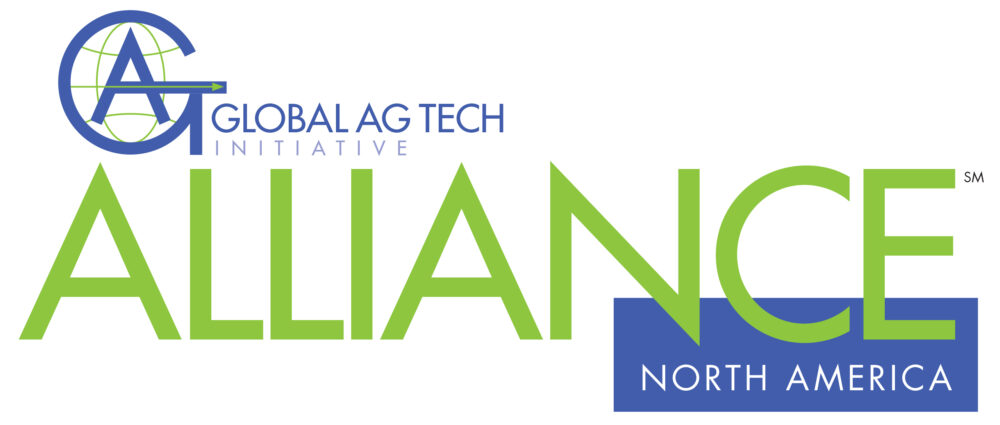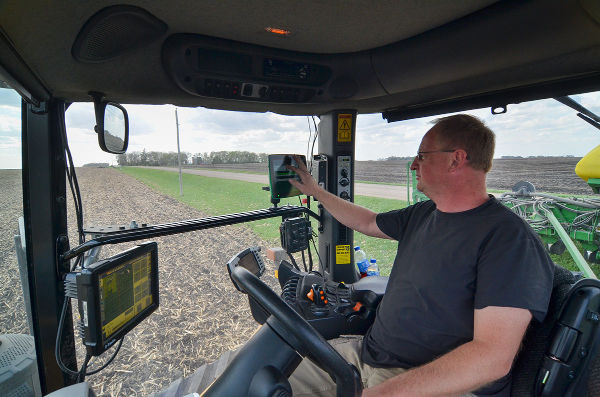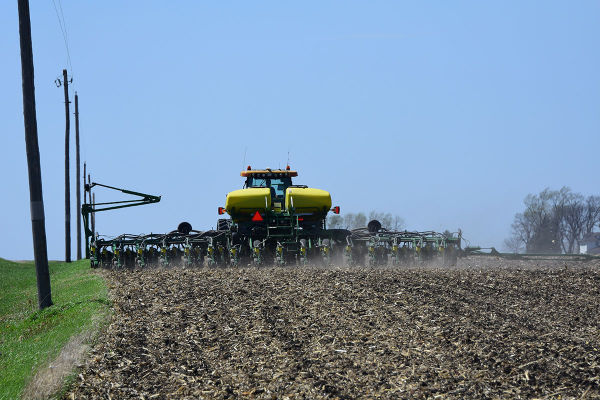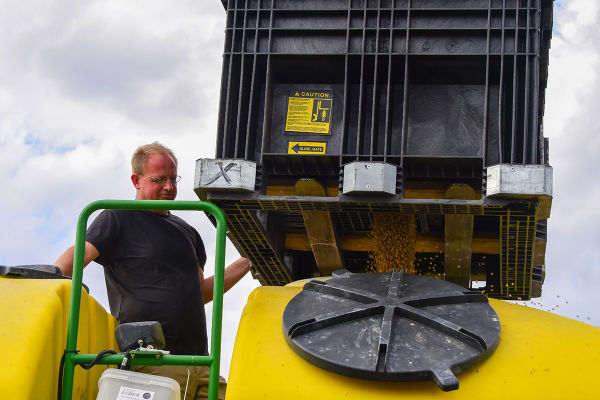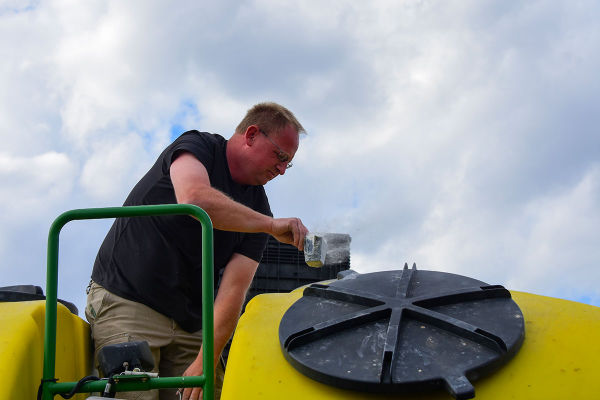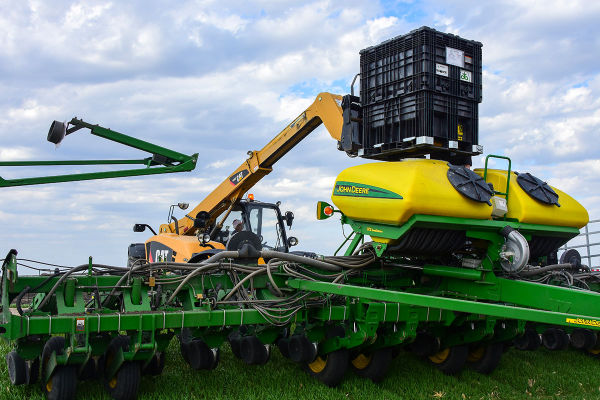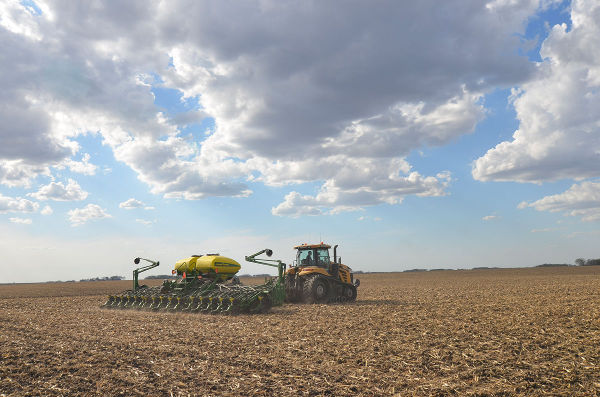Field Stories in Precision Agriculture
Todd Golly
Todd Golly, farmer and co-owner
Golly Farm, Winnebago, Minn. (south-central, established in 1905)
Ag Engineering degree, University of Minnesota.
Farms with brother Tim and parents Tom and Judy Golly, along with wife Mindy and children Tyler, Thomas and Gigi.
- Crops: 6,000 acres, corn-soybean rotation (all 15-inch rows). Some identity-preserved crops like soybean seeds and high-oleic soybeans.
- Soils: Dark and heavy with good OM, rely on drainage tile. Test every two years.
- Fertility: Variable rate by zones (yield and soil).
- Tillage: High-speed minimum-till disk (Horsch Joker) once, then field cultivate, then plant.
- Livestock: None. Ex-swine producer, and parents had beef herd.
- Technology: Mental acuity, Excel spreadsheets (math!), yield monitors, autosteer, RTK guidance, grid soil sampling, sprayer boom shutoff/direct injection, variable-rate fertility, narrow-row crops, whole-farm analysis, in-field research/testing, drone.
Follow Todd’s Journey through the 2020 growing season
Meet The Farmer
Golly Farms Evolution to Precision: It’s the Math (Part 1)
Southern Minnesota farm applies engineering mindset with economic sensibility to improve new technology adoption decisions.
Article by Kurt Lawton
Make no mistake, Midwest grain farmers get paid by the bushel. Some farmers try to win with the most bushels. In Todd Golly’s world, “I’m not always chasing yield.”
As an admitted early adopter of precision technology, driven by his agricultural engineering degree, Golly believes in yields trending up, but financials must drive agronomic decisions.
“We’re really trying to become more efficient on the bottom line without sacrificing yield. As an analytic guy, my technology and agronomic decisions must prove their value on our acres. That’s why, for example, we tested 15-inch row corn for four years before we shifted away from 30-inch on all our acres. The same method also proved greater efficiency by switching from a ripper to a high-speed disk, without losing yield while managing corn residue.”
Constantly learning is key
Golly’s love of farming, rural life and machinery began during his youth on their now 120-yr-old farm outside of Winnebago, Minn. His parents, Tom and Judy Golly were local school teachers before they decided to go back and farm where they grew up.
That family education philosophy stuck with Todd, who combined his farming and machinery love to achieve an agricultural engineering degree at the University of Minnesota. His brother Tim headed down a similar path, currently an aerospace engineer in the Twin Cities, while maintaining involvement in the family farm business.
During college, Todd fueled his learning with an internship at a large machinery company as well as doing work for the University of Minnesota’s Precision Agriculture Center. “I was fortunate to talk to people around the world and learn about technologies back when precision ag was starting in the mid-90s, during the early days of yield monitors and auto-steering.”
Golly enjoyed absorbing the tech side of agriculture, but the pull to try his hand at farming was stronger. “I missed being in a small community on the farm, working for myself, and knowing that my dad was very open to change,” Todd says. “My dad worked aggressively to build a good land base, then together with my drive to be an early adopter of technology, we continue to make the family farm more efficient.”
Technology changed record mindset
Beginning with early yield monitors, basic auto steer and GPS, Golly quickly discovered the advantages of fuel, time and labor savings—several years before anyone in his area. “We became more efficient. Accurate and honest information with everything, especially your yields and your costs, is the key to success, as is flexibility and the willingness to change. If you do the same thing for 25 years, it’s not going to work, because your competitors are always getting better.”
Being a first adopter of technology means you might miss some later model refinements, but you gain the advantages of quicker success, Golly says. “Sure, there are some failures, which can almost teach you more, as long as it doesn’t cost too much,” he laughs. “But after you have successes, you want to continue to learn more, as you’re always looking for that next success.”
This pioneering technology really kicked off what Golly likes to call the better management revolution, more so than the often coined data revolution. “We were getting better information for our accounting, making our financial reporting better. And this changed our mindset to develop better records throughout our farm,” he adds.
While Golly admits he should have focused more on the business, accounting and marketing side of farming during his college years, his engineering mind and love of Excel spreadsheet capabilities led to efficiencies beyond classroom lectures.
Tech adoption boils down to math
Golly says part of tech adoption is just the mental aspect—if it makes you and your employees feel good to adopt—to do things more efficiently. The second part is financial analysis, as he believes about everything boils down to math.
He uses Excel spreadsheets with custom formulas to make many decisions. For example, he’s judged tractor efficiency with and without autosteer, looked at whether adding a planter or combine is feasible, and checked the value of planter and sprayer add-ons like row/boom shutoffs.
“I put all my fields into Excel, calculate the number of various equipment passes, then I can determine fuel and time savings, how fast the technology will pay for itself or not pay, see if the math equation works, then adopt.”
Along with field testing and math, Golly says that one of the most important things he has ever done was to join a farmer peer group about 25 years ago, put together by the University of Minnesota. “This is the one quarterly meeting I don’t want to miss, as this group of similar-sized, technology-based farms is a great trusted and honest group. Bouncing ideas off of peers is so important, as well as scheduling and sharing on-farm research that we do. Everything from hybrids, herbicides, and populations, to planter speeds, fungicides, biologicals, cover crops, tillage, even government programs. This group helps all of us adopt more to increase efficiency,” he says.
Golly Farms adoption journey
Their tech journey began with early yield monitors, which took yield from a basic field level to a map showing unexplained variability within fields. “Once we understood this granularity, it led to changes in soil sampling as we tried to figure out whether variability was caused by soil or topography or other things,” he says.
The next phase was early autosteer—basically a straight line—to simply try to get more hours out of equipment. “We were able to plant and do tillage through lunch breaks, eating on the go, and we weren’t as tired at the end of the day,” Golly adds. Fuel savings help drive the economics, along with landlords impressed by completely straight rows.
An important agronomic technology that Golly adopted after autosteer was 15-inch row corn since he already had narrow-row beans. “We’ve done 15-inch corn for over 20 years now. It took four years of testing to convince us it was best for our farm. Now we achieve better yields, have lower input costs, less erosion, better weed control, cooler soil temperatures, and other benefits.”
Golly says their next wave was driven by the desire to reduce herbicides costs. They invested in sprayer boom auto height sensing and boom shutoff to avoid overlap and cut costs. Direct injection was added to safely use different chemical combinations as well as changing rates on the go.
Economics of expensive seed led to the addition of planter monitors. “If you don’t do a good job planting, given high seed costs, you’re out of luck for the rest of the season, especially on 15-inch rows,” he adds. They did not adopt row shutoffs, as payback would have probably taken 20 to 25 years given Golly’s straight rectangular fields.
In the last five years, Golly Farms has added whole-farm analysis and drone technology. Not finding a software package that fit what Golly wanted to do, he built a customized Excel spreadsheet that includes every piece of data from the farm. “We can do everything from profit analysis on each field to input analysis, loan analysis, everything on a giant spreadsheet,” he says.
Drone adoption came from Golly’s growing up learning the value of seeing crops from the air, as his dad was a pilot. “We were one of the first farms in the U.S. to have a fixed-wing drone. We flew all our fields using NDVI and thermal technology, trying to get an understanding of better zones so we can fertilize according to those zones,” he says.
With the goal of better field scouting, Golly also launched an ag-tech startup company called Leading Edge Technology in 2014, selling UAVs, software and knowledge. It has since evolved into Aker Technologies with an expanded crop scouting business model. While no longer involved in the day-to-day business due to time constraints, he remains a board advisor.
Goals for 2020
Beyond the overriding goal of surviving this year, Golly plans to gain additional knowledge in several areas. He is conducting more trials of narrow-row corn hybrids, gathering new data from his Precision Planting SmartFirmer technology, seeking to demo new planter technology and possibly explore an autonomous machine, while exploring some ideas that could launch another startup business.
An engineering mind rarely rests.
————–
Kurt Lawton has been an agriculture journalist for more than three decades, with a special passion for the technology side of the business. He currently operates his own freelance content firm, Stellar Content, based in Eden Prairie, MN.
In-Season Update
Golly Farms Evolution to Precision: A Slow and Strange Summer (Part 2)
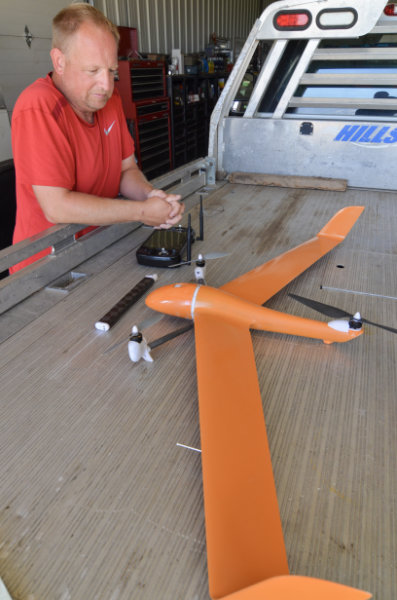 Southern Minnesota farm applies engineering mindset with economic sensibility to improve new technology adoption decisions.
Southern Minnesota farm applies engineering mindset with economic sensibility to improve new technology adoption decisions.
Article by Kurt Lawton
“It’s been a quiet week in Lake Wobegon.”
This famous weekly lead-in to the news from a fictional rural Minnesota town on the Prairie Home Companion radio show has felt strangely true as Todd Golly recaps his summer on the family farm.
“As farmers, we’re use to working alone or with family and a few employees, but this year is unlike any other. The summer has seemed slow—no company sales reps or research techs coming by; no equipment companies bringing new technology to test; almost no grain hauling as ethanol plants are closed or barely open; no kids activities; no summer farm shows or county fairs.”
Golly says it’s just not the same when personal visits are replaced by more computer screen time with email and Zoom meetings. “Yet the waterhemp are still hanging around,” he chuckles.
Crop season changes
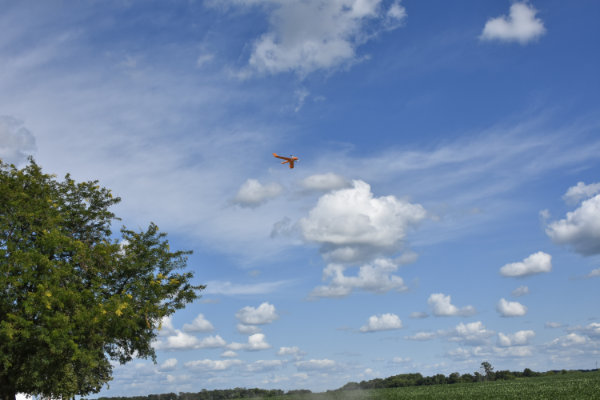 On our second visit to Golly Farms near Winnebago, Todd and his drone pilot and previous co-worker Erik Johnson were launching his FlightWave Edge, a hybrid tricopter fixed-wing UAS aircraft to get in-season images from a nearby field.
On our second visit to Golly Farms near Winnebago, Todd and his drone pilot and previous co-worker Erik Johnson were launching his FlightWave Edge, a hybrid tricopter fixed-wing UAS aircraft to get in-season images from a nearby field.
His changes so far this season run the gamut from increased spring tillage and early planting issues to more ground application of herbicides, last-minute dicamba regulation changes, a lack of new technology testing, and the commodity market challenges of ethanol plants closing.
Last year’s late harvest, with some corn being combined in the snow, led to more issues with volunteer corn this spring in soybean fields. Golly says tillage also played a role, as very few acres saw a chisel plow last fall, opting for faster shallow tillage with his Horsch Joker compact disk. “Good news is we’ve got numerous unplanned fields trials now with different tillage types and timing, so I’m hoping for data that will allow a greater shift away from the chisel plow. We would have been in serious trouble without the speed of the Joker combined with a dry spring.”
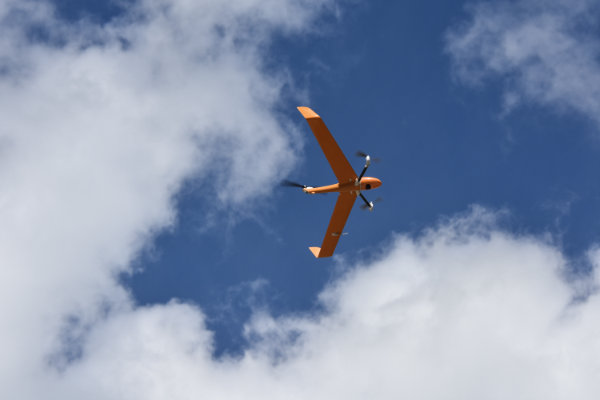 The fortunate early planting season—the opposite of 2019—aided the volunteer corn, as Golly says it had not emerged before their early spraying.
The fortunate early planting season—the opposite of 2019—aided the volunteer corn, as Golly says it had not emerged before their early spraying.
Since another herbicide application was needed for volunteer corn, Golly shifted to spray more acres with his ground rig, deciding to add insecticide and fungicide—reducing the need for aerial fungicide application.
And in his annual battle with multiple herbicide-resistant waterhemp, he decided to walk beans in one 40-acre field. “We couldn’t use dicamba due to surrounding fields lacking resistance to the herbicide, and Flexstar just burnt the weeds but they came back. So, we’re just cleaning up that area to protect it until we can get it next year in corn,” he says.
Dicamba rule changes
The biggest agronomic issue was the whole dicamba fiasco this summer, says Golly. “There were a few days we couldn’t spray dicamba because it all of a sudden became illegal, but then the label was re-approved. Plus, the challenge with the cutoff date means we’re scrambling to get acres sprayed, while the small weeds start growing afterwards,” he says.
“We need every tool we can get right now in the fight against waterhemp, as dicamba, Liberty and Enlist are all failing due to increasing resistance. Dicamba is a great tool, but it’s not perfect.”
Record crop storage issues
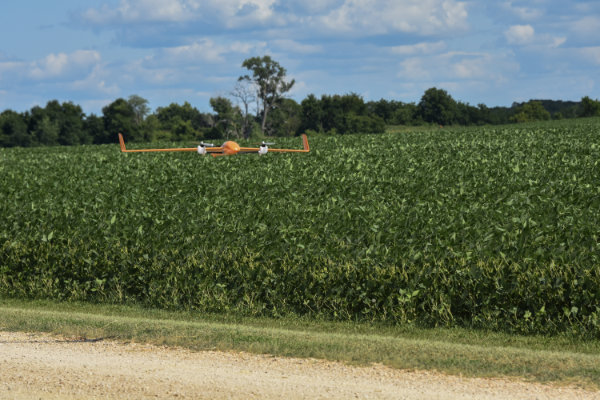 In Golly’s area of southern Minnesota, nearly 100% of all corn is marketed through contracts with ethanol plants. Due to Covid keeping a lid on drivers and fuel consumption, the majority of ethanol plants in the area have shuttered. This means farmers haven’t been emptying their on-farm storage at the normal pace, with a big crop looming in the fields.
In Golly’s area of southern Minnesota, nearly 100% of all corn is marketed through contracts with ethanol plants. Due to Covid keeping a lid on drivers and fuel consumption, the majority of ethanol plants in the area have shuttered. This means farmers haven’t been emptying their on-farm storage at the normal pace, with a big crop looming in the fields.
“We have six ethanol plants, many closed for months, and they have a difficult time restarting,” Golly adds. “We’re still only at 50% capacity, so many are scrambling to figure out what to do.
Like many farmers, Golly doesn’t like to admit to a good crop in hope that prices move up. “The reality is I think Minnesota is going to crush the all-time yield record this year, if we continue to get timely rains to put that last 25% of weight on the grain,” he says. “I hate to jinx it, but we probably have 65-70-bushel beans and 250-bushel corn, which is about 10% more than a very good crop around here.”
USDA Crop ratings agree
In fact, the August 9 USDA crop progress report for Minnesota bears out Golly’s thoughts. Both corn and soybean conditions were rated 84% good to excellent. Corn maturity was 12 days ahead of last year and soybeans were 14 days ahead. Soil moisture tells another good story with 74% of topsoil and 79% of subsoil acres rated adequate.
So the challenge becomes, where to put the new crop? Farmers here have also lost buyers outside of the fuel industry, as many local co-op elevators no longer buy and store grain, meaning unit trains don’t come through with empty grain cars anymore.
“Between ethanol, the virus and trade issues, we don’t know what to plan for right now. China is finally buying their share of grain, but with this giant new crop, it’s going to be tough on everybody. Something needs to change or it’s going to be a pretty sad winter. It’s amazing how all this technology has outpaced the demand, considering how demand continues to grow,” he says.
Drone research improves field zones
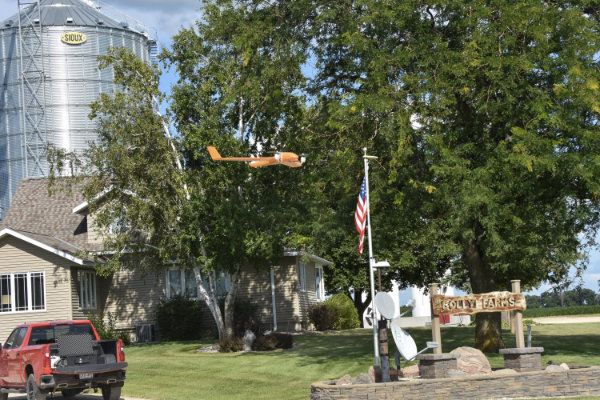 Having founded and served as COO for several years of an agtech startup company that used drones to improve field scouting (Aker Technologies), Golly knows how to use drones for research.
Having founded and served as COO for several years of an agtech startup company that used drones to improve field scouting (Aker Technologies), Golly knows how to use drones for research.
He is always looking for the next best thing to be more efficient. As Aker’s older drone fleet was getting pretty beat up, since landing a fixed wing is challenging in areas without ditches or roads, he searched UAV shows for better technology. “I love this FlightWave Edge that can takeoff, hover and land like a tricopter and fly like a fixed-wing airplane. And you can buy different payload cameras and sensors for many uses,” he says.
During our visit, we watched the FlightWave Edge takeoff vertically, climb to 400 feet to make its field passes, then return to the same spot as takeoff. It flew the pre-programmed flight plan for a 70-acre field in 12 minutes. He says it only takes a quick 15 minutes for full processing with the software.
“During the last three or four years, I’ve flown all my acres for NDVI. My goal is to combine data from soil samples, NDVI and yield maps to really fine tune fertility zones. Not to necessarily cut back on fertilizer but trying to spend the same amount and put it in the proper locations,” he says. “Between the three of them, you can make some nice maps that are pretty accurate all through the season.”
Golly conducts a lot of on-farm research every year, but it has slowed this year due to Covid cutting back the ability of company people to travel and help with the plots. He did continue some ongoing fungicide trials in corn and soybeans, along with some work with foliar biostimulants.
He learned the most from a 300-acre corn fungicide trial he conducted several years ago. “Erik and I flew it every single week, and documented how each fungicide changed the plant health,” he says.
Golly found it fascinating because each one of the three fungicides showed a different timing of when it affected corn plant health. “One provided a quick burst after application, one produced a burst at the end, and the third one was like an IV producing a low steady drip. Each one kind of changed according to the rainfall we got, too.”
His takeaway was excellent knowledge to really fine tune fungicide timing. “I spray fungicide earlier than I ever have because of that plot, and I stick to a certain class of fungicide,” he added.
New business ideas continue
The last sentence of Part 1 (Meet the Farmer) “an engineering mind rarely rests” held true during this quiet, odd summer. Todd and some partners are working on a project that, he says, has the potential to benefits many farmers. But he won’t disclose his engineering mind until later this year.
————–
Kurt Lawton has been an agriculture journalist for more than three decades, with a special passion for the technology side of the business. He currently operates his own freelance content firm, Stellar Content, based in Eden Prairie, MN.
Harvest Scorecard & Post Season Evaluation
 Golly Farms Evolution to Precision: Harvest Data Empowers 2021 Decisions (Part 3)
Golly Farms Evolution to Precision: Harvest Data Empowers 2021 Decisions (Part 3)
Southern Minnesota farm applies engineering mindset with economic sensibility to improve new technology adoption decisions.
Article by Kurt Lawton
Ideal weather—aside from a six-inch October snow—helped deliver record yields and more improved data during 2020 for southern Minnesota farmer Todd Golly.
We caught up with Golly on November 5th as he and his brother Tim were piloting their two Case IH combines across their last field of 2020. “We had best-ever yields in corn and soybeans, with cornfields ranging from 240 to 260 bushels per acre and soybeans exceeding 60 bushels.”
Aside from losing about five harvest days and some subsequent higher grain moisture due to the early blizzard, fall harvest weather was warm and cooperative. On top of that, the market came through with higher grain prices.
Beyond equipment and weather, Golly faced a Covid-19 virus scare from an employee in the middle of harvest, when the two closest hospitals had no available beds. “Fortunately, he quarantined and recovered, but it makes you quickly adjust to thinking about employee and family safety, as well as future planning thoughts regarding additional employees,” he says.
Reviews data in the cab
Golly’s analytical engineer’s mind rarely rests during the long hours in the combine seat. Thanks to auto-steer and data flowing into his iPad from his Climate software, he watches yields of hybrids and varieties by management zone to formulate seed, fertilizer and weed control input decisions for 2021.
To calculate his interest in newer hybrids, usually in short supply during early order, he analyzes his current seed lineup by field to find the good, the bad and the ugly. “I look at true side-by-side data by individual field because it’s unfair to compare numbers across different fields that are better or worse,” he adds.
Since Golly grows corn in 15-inch rows, he pays more attention to hybrids at the top and bottom of test plots, looking for tendencies since 30-inch row yields don’t equate to 15-inch farming. “I also look for more vertical leaf structure to take more advantage of the sun given narrow rows.”
His seed company advisors also play an important role. “Once they understand my fields, my likes and dislikes, they provide good advice. Then I match their recommendations with my knowledge to make final decisions,” Golly says.
In the cab, Golly also reviews soil samples and prescription maps in the various yield zones. “I need to make sure we keep the variable-rate fertilizer being spread in order to follow that with my shallow tillage,” he says.
Trait selection and plant populations
As the combine chews through every acre, Golly looks for weed control issues to adjust herbicide-resistant seed traits used in 2021.
“Enlist may be the best technology, but the bean yields aren’t there yet for this area, but it’s getting close. Dicamba plus a residual didn’t work quite as well this year, so I will shift my soybean traits to the Liberty program to add flexibility and fight waterhemp resistance.”
To complete his seed technology calculations by field, he looks at results of this year’s maturity groups and plant populations. “I have a tendency to plant later varieties than anyone else in this area (110-113 day), mostly because our data shows it pays off, and I have an updated dryer with no fear of using it.”
Regarding seeding populations for his 15-in. rows, Golly plants 155,000 soybean seeds per acre to finish at 120,000. “I used 36,000 population for corn this year, but with the good weather we had, I probably could have pushed it to 38,000 or 40,000. It seems like hybrids are getting better at higher populations to increase yield, given the right environment and management.”
 In this 15-in row environment, Golly is a firm believer in 100% use of foliar fungicides on corn and soybeans, proven by his years of data delivering good ROI. “For 2021, I’m shifting some acres from Delaro to the new Delaro Complete because of the added plant health benefits. The addition of better roots and better plant protection is fantastic in a drought year if 2021 predictions come true,” he says.
In this 15-in row environment, Golly is a firm believer in 100% use of foliar fungicides on corn and soybeans, proven by his years of data delivering good ROI. “For 2021, I’m shifting some acres from Delaro to the new Delaro Complete because of the added plant health benefits. The addition of better roots and better plant protection is fantastic in a drought year if 2021 predictions come true,” he says.
One technology he’s keeping his eye on is the short-stature corn from Bayer. “I was intrigued when I saw a nearby field plot this summer. If it will yield with only half the residue, that would be great.”
Constant field zone improvements
Golly doesn’t plan on any fertility adjustments for this year, other than continuing to tweak his management zones based on more data. He is comfortable with his variable-rate prescriptions that drive up yields more rapidly in the good areas while delivering acceptable smaller gains in lower-yielding zones.
“Yield really comes down to topography that changes the moisture profile during the season, and Mother Nature controls that moisture content. You can always throw more money (fertilizer) at it to get more yield, but not necessarily more profit. By adding more data layers—soil samples, yield history, SmartFirmer data, manure analysis—we can adjust zones to increase profit margins. Our testing, and going the extra mile with management and inputs, gives us a leg up on the competition.”
Tillage also plays into greater profit margins at Golly Farms. Once a chisel plow loyalist, Golly began conducting some side-by-side yield and residue tillage trials with a shallow high-speed Horsch Joker disk.
“What we found over several years is it costs us 66% less to run the Joker versus the chisel, which is a big time and cost savings,” he says. “We continue to see no yield drop, and residue management is very good. Headlands will still be chiseled due to compaction if there is time after harvest.”
Precision technology data gains
 Golly began the season by collecting new data in the planter furrow, testing Precision Planting’s SmartFirmer. He likes gaining data during planting, rather than doing a separate pass across the field, like a Veris tool. “I was impressed with the EC and soil moisture/temperature data. The organic matter and CEC maps were shockingly good, so I can’t wait to get another year or two of data from it. It looks like it will provide more valuable data layers to improve my zones and prescriptions,” he adds.
Golly began the season by collecting new data in the planter furrow, testing Precision Planting’s SmartFirmer. He likes gaining data during planting, rather than doing a separate pass across the field, like a Veris tool. “I was impressed with the EC and soil moisture/temperature data. The organic matter and CEC maps were shockingly good, so I can’t wait to get another year or two of data from it. It looks like it will provide more valuable data layers to improve my zones and prescriptions,” he adds.
He ended the crop year with a demo of a new Case IH combine with Harvest Command automation system. One combine is getting old with more than 5 million bushels run through it, so it may be time to trade soon, he says.
“The sample in the grain tank was so clean it was amazing. The sensors and cameras and automation—it was fascinating to watch settings change as harvest conditions and hybrids changed,” Golly says. “Even though we don’t necessarily get paid for clean grain, if this technology saves time, some bushels and improves soybean storage with less mold potential, the value is probably worth it just for that protection. But only when it is time to replace a combine.”
Unfortunately, due to Covid, Golly could not test some coming technology in the AI space, due to companies canceling travel and farmer meetings. “My engineering mind loves to work with companies on their autonomous technology to help get it market-ready. I’m also intrigued by the next generation sprayer boom technology like John Deere’s See and Spray System. It could be a huge game-changer for farmers and the environment when individual weeds are the only thing that gets sprayed.”
Grain bin technology value
One precision technology that saved Golly a lot of time and grain this harvest is his OPI grain storage management system. He watched and managed 750,000 bushels from his smartphone, where he also receives texts when the temperature changes by five degrees.
“It’s been a very tough year for storage, as early grain went in hot with our 70-degree weather, so we had to cool it in stages until the night temperatures dropped. The bin sensors and fan automation handled the temperature and moisture extremes well, with grain coming out close to 15% moisture. This technology has come down in price so much that I’d highly recommend growers look at it—even if only using one sensor in the middle of a smaller bin,” he adds.
Golly Farms uses the technology to manage three bin sites with varying bin sizes that use from 1 to 7 sensors per bin. The farm delivers from 50,000-75,000 bushels per month, ranging from ethanol plants to food-grade soybean facilities. And they don’t fear identity-preserved grain, growing seed and food-grade grains during years when they can secure added profit.
Software technology and Excel brilliance
As the proud developer of a massive, customized Excel spreadsheet that tracks and evaluates his entire farm business, this computer time is where Golly’s engineering mind geeks out on his dozens of formulas that continuously fine-tune ROI and profit.
 His spreadsheet began with the goal to easily prepare information for the banker every year—the cash flows and balance sheets. It features sections for cash flow, projections for the coming year, yields by field, grain marketing contracts, inventories, loans, scale tickets, planting plan, land values, land rents and formulas designed to tie everything together.
His spreadsheet began with the goal to easily prepare information for the banker every year—the cash flows and balance sheets. It features sections for cash flow, projections for the coming year, yields by field, grain marketing contracts, inventories, loans, scale tickets, planting plan, land values, land rents and formulas designed to tie everything together.
Since learning is a constant, it drives him to check out other management software. “I’m a fan of Pioneer’s mobile app software that accurately estimates yield by taking a photo of ears of corn. That led me to examine its Granular farm management software this year.” Golly was impressed with their satellite image technology; the basic analytics for planting dates, hybrids and soil types; the potential for nitrogen and more. “It got my attention, so I will continue to use it.”
He also plans to demo Harvest Profit business software this winter. Eventually, Golly would like an easy program to pass on to the next generation, print nice-looking reports, pull in cash and futures markets and be accessible from the cloud on other devices. This is what he lacks on his Excel spreadsheet, along with instruction on how to use it.
Expand learning with peer group
Another crucial part of his continuous learning mantra, Golly missed the in-person interaction with his farmer peer group that usually met quarterly until Covid happened. “Farmers need interaction to get through tough times together, especially since we’re normally isolated on our farms. Texting, email, phone calls, even Zoom meetings, it’s just not the same,” he adds.
Golly has been part of this technology-loving farmer group for 25 years, initially started by the University of Minnesota. “I highly recommend that all farmers look beyond their local area for peers who can challenge each other honestly and help each other grow. We have a group that trusts one another, gives honest feedback, conducts research and has a lot of fun together.”
Continued learning over 40 harvests
While Golly realizes he only has 40 crops in a lifetime, his engineering mind won’t allow him to make drastic changes from year to year. “I don’t make rash decisions based on one year’s data, but if it looks good, I will expand my acres until it is proven and adopted across all fields where appropriate.”
He believes in a slow process of making sure you are right because big mistakes can be costly, especially when you are a first-adopter of technology. “You hope your children can learn from your slow and steady progressive improvement, instead of from your mistakes.”
Lawton has been an agriculture journalist for four decades, with a special passion for the technology side of the business. He currently operates his own freelance content firm, Stellar Content, based in Eden Prairie, MN.
